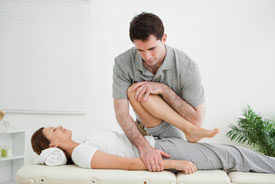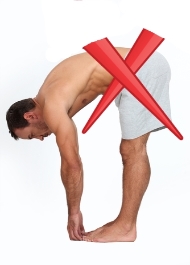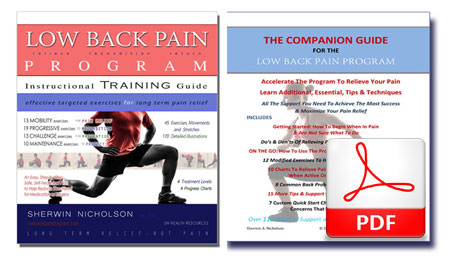Safer Stretching To Relieve & Lower Back Pain
Sherwin Nicholson | Updated May 5, 2020

Chronic back pain? Do you hate to stretch? You may have found the problem.
Don’t avoid it. You need it.
You may not like to hear this but stretching is an important part of the maintenance of long-term health. Your body benefits because it’s what helps to keep your muscles at their optimal working range. This range helps muscles to perform efficiently with minimal injury.
Many people swear up and down about NOT needing to stretch and just wait out the discomfort. But this may work only for the minor times that we experience soreness.
Most of us however will suffer much more severe situations that WILL require a better treatment such as stretching.
Let’s face it, no one wants to hear some big 1600 word lecture about this topic. What we want is results.
Well did you know that:
Without actively lengthening your muscles, you’ll tighten up especially after any muscle strain or injury. And when you tighten up, you will hurt.
As a safe form of exercise, stretching should be part of every daily routine. You’ll have greater control over your body and more awareness of what is needed to remain healthy.
Did you also know that it:
- relaxes and lengthens your muscles
- increases circulation
- reduces tension
- prevents tightness in both the muscles and the joints and nerves affected
- can drastically reduce daily aches and pains
- provides more comfort to the lower back.
- prevents injury
- minimizes back spasms
- prevents stiffness in the morning
- relieves piriformis syndrome
It is not just for toning your body. It helps to relieve tension that builds up throughout the day from daily physical, as well as mental and emotional stress.
There are advantages that stretching brings
They include:
-
- prevention of injury of muscles, joints and nerves
- improves circulation and cardiovascular performance
- increases flexibility and mobility
- relaxes the mind and body
- improves muscle tone
- it is simple and has little risk of injury to the body (when done properly)
- protects you from relying on the health care industry
A healthy routine allows you to become much more aware of the significant and subtle problems that your body may be experiencing. It lets you become better able to spot and address any specific muscle stiffness or tightness.
When your piriformis muscle has become too tight and weak, it is very common for it to put pressure on your sciatic nerve. This causes the sensation of pins, needles and soreness from the buttock. An excellent method for this problem is the piriformis/glute muscle stretch.
You can target and address the area of stiffness or discomfort easier and faster with a good program.
Obstacles to Stretching
 Although it is a very simple and straightforward exercise, it is very hard to stay committed to faithfully.
Although it is a very simple and straightforward exercise, it is very hard to stay committed to faithfully.
Because it is not known for being a comfortable or enjoyable practice, many people avoid doing it because they are already suffering some degree of discomfort. With added discomfort, stretching in addition, can be discouraging.
The other problem associated is that people will generally stretch on an as needed basis. This means that they will lengthen the affected muscle just to the point of relief but not beyond this stage to ensure lasting relief.
This discomfort usually returns, and the person repeats the same minimal technique or assumes that it is not effective and pursues another form of treatment or exercise to relieve their discomfort.
The major challenge is not the practice itself or the individual movements themselves, but the actual commitment. Most of us would much rather avoid stretching because we do not believe that long-term commitment is necessary. However, for the benefits to be long term, the commitment must also be. It is the same with all other physical exercises and activities.
The Value of a Stretch-Minded Lifestyle
A muscle will lose mass and strength if it is not challenged routinely. Your cardiovascular endurance also will last only as long as you are performing endurance related exercises.
Likewise, muscles tend to become shorter with time  as they are contracted everyday more often than they are lengthened back to their desired size. The optimal length of a muscle is always gradually shortening as a result and requires periodic lengthening to operate in a comfortable range.
as they are contracted everyday more often than they are lengthened back to their desired size. The optimal length of a muscle is always gradually shortening as a result and requires periodic lengthening to operate in a comfortable range.
Misunderstandings with Stretching
There is also a misunderstanding with those who are inexperienced with stretching. Most believe that the intensity, duration and time commitment demanded of a healthy program is a constant. They believe that it requires a fixed amount of time and level of discomfort whether at the beginning or many years later.
This misunderstanding discourages the beginner as they are led to think that the challenge that they face when they are in the early stages will be the same in the long term. This is only the case if the problem is not properly treated and they must repeat the same ineffective technique repeatedly. Poor technique (side photo) is a common cause of discomfort, a risk of further injury and causes a beginner to quit easily.
Part of the misunderstanding for the beginner is that they believe that stretching does not require as much time as they initially realize.
The Initial Challenges of Stretching
For muscles that are shortened, tight and have little strength, they require a significant investment of time. These muscles have lost the length and strength over a long period, and discomfort is not usually evident until significant muscle shortening has occurred.
When first attempting to lengthen a muscle that has diminished to such an extent, the beginner must condition a muscle and joint that is at first very resistant to the new range.
The muscle is either being protective (muscle guarding), too  shortened or weak or injured and is being protective by other muscles involved. When faced with such resistance, the beginner becomes quickly discouraged and may avoid stretching.
shortened or weak or injured and is being protective by other muscles involved. When faced with such resistance, the beginner becomes quickly discouraged and may avoid stretching.
They may continue to but will be in such an early stage, that they believe that they are performing the movement well.
You have to be persistent in order to succeed at stretching
Persistent, controlled and safe stretching to a resistant muscle is what will make the muscle less resistant and allows it to yield and relax to the demand of the movement. This is the point at which the muscle develops long-term gains, lengthens and allows greater flexibility to the affected joint.
The goal is to bring the muscle back to its ideal length and range of motion and not just until the pain decreases. The ideal range of motion and length are much longer than the ‘comfort’ zone of the muscle.
It would be similar to not finishing your full 10-day dose on antibiotics because your symptoms of fever and infections are already relieved. When one lengthens their muscle past this threshold and commits to a long-term practice, then the initial discomfort and injury that required the stretch will subside.
What occurs during the initial stage is merely a tug of war with highly resistant muscles. The muscle does not truly respond but simply fatigues and temporarily lengthens only to tighten up again.
In reality, the initial challenges change over time as the muscle and joint learn to respond more. This amount of time and effort that you dedicate gradually becomes easier and requires a much shorter time to lengthen to achieve comfort. After a period, you will be able to lengthen your muscles faster, easier and with much less discomfort. The joint affected will also respond as a result.
Stretching Methods
There are many forms and ways available and each have their advantages and disadvantages. Many are highly recommended.
- static
- dynamic
- passive
- active
- PNF
- functional
The benefits of the different types can easily be found from sources such as the Internet, trainers or other reading sources. Please feel free to search and learn the movements and exercises related to each type.
This website encourages any kind that is beneficial and long-term for the health of the lower back. The Low Back Pain Program promotes exercises that incorporate many types of stretches that will help you. They are specific and target areas of the lower back and hips that are a source of discomfort. They help to bring balance, strength, increased mobility, an improved range of motion and to have relief.
For cases of lower back pain, it is not merely the particular type, but the investment in time. Everyone has a different cause with different muscle groups and joints involved. They each require varying degrees of effort, intensity and time toward managing and progressing in a program for lower back problems.
The eBook helps to provide such direction and allows the user to work with various lower back exercises and stretches specific for that person.
Many used in the program are variations and adaptations of effective methods preferred for lower back pain. The advantage is in the variation. They are modified to be easy and practical with everyday activities that you can do as needed with little investment of time when mastered.
You can use these methods at home or out of the home as you perform other daily movements that are complementary to the stretch. In time, it no longer seems like a chore or duty but rather a movement and even a personal challenge. After a while, you will be able to spend less time required performing them as you feel better and find maintenance type stretching to only be necessary.
How to stretch to relieve sciatica
Loosen your piriformis to relieve hip pain
Start Now With These Proven Stretches!
References:
- Core Training Anatomy – Dr. Abigail Ellsworth. Baker & Taylor Publishing Group, 2010.
- Mobilization Exercise-Comparison between Specific Lumber Mobilization and Core-Stability Exercises with Core-Stability Exercises Alone in Mechanical LBP.-http://www.ncbi.nlm.nih.gov/pubmed/24639852
- Delavier Anatomy – RA781.63D4513, 2010. Frederic Delavier. Human Kinetics Publishing.
- www.nih.gov (The National Institutes of Health)

